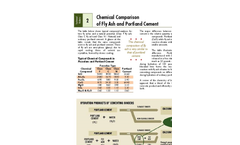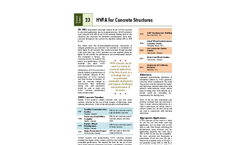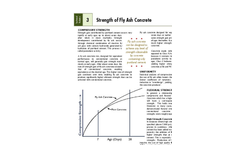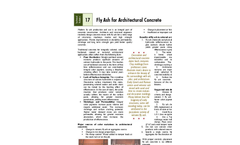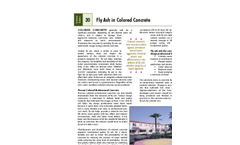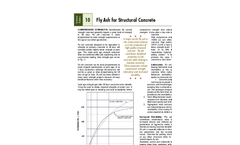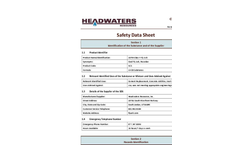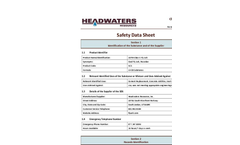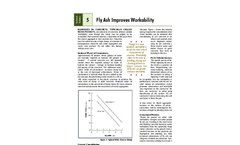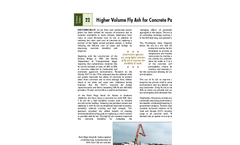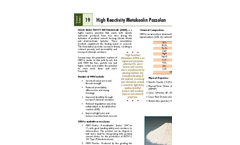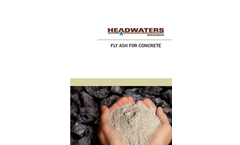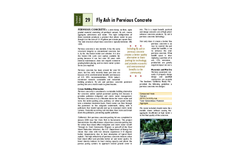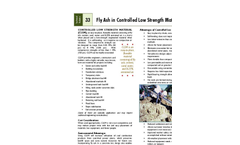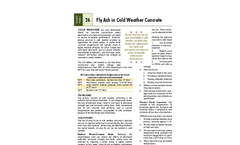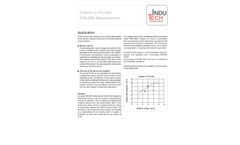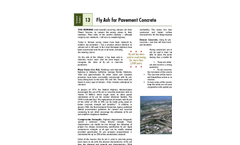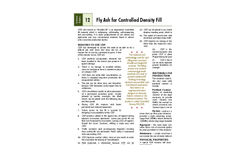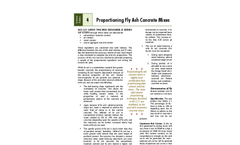fly-ash Downloads
62 downloads found
The table below shows typical compound analyses for two fly ashes and a natural pozzolan (Class F fly ash, Class C fly ash and Class N - Natural) and ordinary portland cement. A glance at the table reveals that the same compounds exist in fly ash and portland ...
IN 1981, long before using high volume fly ash (HVFA) concrete in structural applications was an accepted practice, EHDD architects used concrete with 40% fly ash in the seawater holding tanks in the Monterey Bay Aquarium for durability considerations. Since then, concrete throughout the country has regularly utilized 20% to 35% ...
Strength development contributed by fly ash occurs through chemical combination of reactive fly ash glass with calcium hydroxide generated by hydration of portland cement. ...
Modern fly ash production and use is an integral part of concrete construction. Architects and structural engineers routinely design concrete mixes with fly ash for a wide range of structures, roadways, marine and high strength applications. ...
Protecting the concrete by including fly ash can yield better, longer lasting colored ...
Specifications for normal strength concrete generally require a given level of strength in 28 days. Fly ash concrete is easily proportioned to meet strength requirements at this age or any other age ...
CARCINOGEN LISTED IN: NTP: Yes (Crystalline Silica)* IARC Monograph: Yes (Crystalline Silica)* OSHA: No * Coal fly ash is not a listed carcinogen. Respirable crystalline silica from occupational sources is listed as carcinogenic to humans (Group1) by IARC. ...
CARCINOGEN LISTED IN: NTP: Yes (Crystalline Silica)* IARC Monograph: Yes (Crystalline Silica)* OSHA: No * Coal fly ash is not a listed carcinogen. Respirable crystalline silica from occupational sources is listed as carcinogenic to humans (Group1) by IARC. ...
Concrete must be cohesive even at high slumps to maintain its homogeneous character and avoid segregation and costly rock pockets. Fly ash offers this feature without extra ...
Historically, fly ash from coal combustion power plants has been utilized for reasons of economy and to maintain workability in warm climates. Experience from coast to coast illustrates how fly ash, in addition to reducing the cubic yard cost of concrete by replacing a portion of the higher priced portland cement, is further ...
The asphalt rich binder provides sufficient mortar of the desired consistency for durability, requiring a large amount of mineral filler such as fly ash to convert the fluid asphalt into asphalt ...
Fly ash particles are glassy, spherical shaped “ball bearings” — typically ...
Pervious Concrete is a zero-slump, no-fines, open graded material consisting of portland cement, fly ash, coarse aggregate, admixtures and water. The right configuration of these materials produces a product that allows water to pass though it at the rate of 12-18 gallons per minute per square foot. ...
Controlled Low Strength Material (CLSM), an easy-to-place, flowable material consisting of fly ash, cement, sand, water, and 8-25% entrained air, is a slurry when placed and a low-strength engineered material when hardened. ...
The American Society for Testing and Materials (ASTM) defines pozzolan as “a siliceous or siliceous and aluminous material, which in itself possesses little or no cementitious value, but will, in finely divided form and in the presence of moisture, chemically react with calcium hydroxide at ordinary temperatures to form compounds possessing cementitious ...
However, placing concrete in cold weather provides an opportunity for better quality, as cooler initial concrete temperatures will typically result in higher ultimate strengths. Fly ash in conjunction with liquid admixtures such as calcium chloride, non-chloride accelerators, and mid-range water reducers will further enhance the strength of concrete in cooler ...
The Romans used naturally occurring volcanic ash from Mount Vesuvius to cement the paving stones in their roadways. ...
CDF, also known as “flowable fill”, is an engineered, controlled fill material which is self-placing, self-leveling, self-compacting and non-settling. It is easily proportioned to suit almost any application and uses conventional materials found in almost every concrete production ...
These ingredients are converted into solid volumes. The difference between the sum of the total volumes and 27 cubic feet will determine the necessary volume of sand. Sand weight is then calculated to complete the trial mix proportions. The accuracy of this mix must be checked by physically preparing a sample of the proportioned ingredients and testing the mixture for ...

